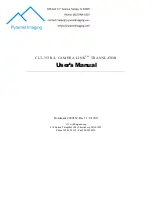
3. MELLOTRON V OVERVIEW
3.1. What can we do with Mellotron V?
3.1.1. The original Mellotron limitations
The original Mellotron M400 (the one which this emulation is based on), although very
popular, had several limitations.
The sound was produced through the replay of magnetic tapes lasting around eight
seconds. The mechanics of the instrument had evolved since the first models, and now
reside in "removable tape frames" each featuring three-track tapes (three sounds in the
same tape), which could be replaced in just a few minutes to install a new set of sounds.
Still, each note produced by the instrument was based on a complete and somehow delicate
tape player mechanism, triggered by the keyboard.
The mechanism included the tape playback head, a pinch roller that descends over a
constantly spinning capstan, and a pressure pad the pushes the tape down to make contact
with the playback head. Add to this the mechanism that takes care of rewinding the tape
once the key is released. Tuning was not very precise either. And the mechanism was prone
to problems.
The Mellotron could only play 35 notes, and if/when the tape reached the end (eight
seconds), the sound would stop, and the tape would have to be rewound back into the the
start position. Only then could that note be played again.
The Mellotron M400 could select between three sound tracks, but since it had all the three
tracks in the same tape, it could also mix between two adjacent tracks, by slightly changing
the position of the playback head, which gave it an extra versatility.
Despite the problems, the instrument became quite popular, because it was capable of
playing some fantastic sounds (the flutes, the violins and the choirs, especially, marked their
presence in countless records), and there were no alternatives for playing orchestral sounds
on stage, except hiring a real orchestra.
13
Arturia - User Manual Mellotron V - MELLOTRON V OVERVIEW
Содержание Mellotron V
Страница 1: ...USER MANUAL...
















































